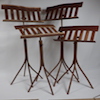So I watched a few youtubers sharpen their planer/jointer blades and I can shave with my plane irons so fI thought I'd give it a go. I settled on a 45 degree X-jig with allen screws to hold the knives IMG_1502.JPG
I sharpened the three HSS 'delta' knives on abrasive paper down to 1500 grit and the edges were fine with a slightly rolled edge. I flattened them on 1000 grit and there were no flat spots. They cut like scalpels. But on the first use, I was truing up another bit of the oak from which I made the jig and this happenedIMG_1501.JPG Is it possible to get an HSS knife too sharp? is the metal not hard enough to survive a knot in red oak?




 Reply With Quote
Reply With Quote



